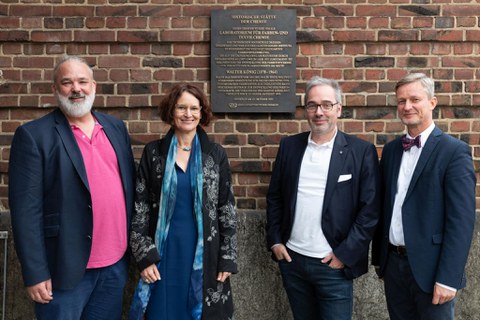Oct 12, 2023
TUD’s König Bau with the Historical Collection of Dyes honored as "Historic Site of Chemistry

From left: Prof. Jan J. Weigand, Kirsten Vincenz, Jan Gerken and Dr. Andreas Handschuh
With a festive ceremony today, Thursday, 12 October 2023, the König Bau of the TUD - Dresden University of Technology and the Historical Collection of Dyes was assigned in the program "Historical Site of Chemistry" by the German Chemical Society (GDCh). The historic building complex with the unique collection of dyes is honored as an outstanding and unique place of dye chemistry research and thus receives a national recognition that has so far been granted to only a few universities in Germany.
The collection of dyes in its still original historical interior in the König Bau on the core campus of the TUD is unique in Europe. As one of the university's most important collections, it houses more than 8,000 natural dyes from plant and animal sources, over 18,000 commercial samples of synthetic dyes from more than 80 manufacturers, arranged according to their chemical structure, as well as over 2,000 color sample cards and numerous dye samples. The oldest dye samples date from around 1830, other samples from the 1851 World's Fair. Since 1926, the collection has been housed in the collection rooms in the König Bau of the TUD, adjoined by a dye chemistry laboratory and the historic lecture hall.
The German Chemical Society (GDCh) honors the originality and special significance of this academic heritage by awarding the distinction "Historic Site of Chemistry" at a festive ceremony on the campus of the TUD. Accompanied by greetings from TUD’s Vice-Rector University Culture Prof Roswitha Böhm, State Secretary Dr Andreas Handschuh, the GDCh Dresden Chairman Prof Jan J. Weigand and the Dean of the Faculty of Chemistry and Food Chemistry Prof Stefan Kaskel, a scientific program with talks by Prof. Horst Hartmann, Prof. Karl Leo and others framed the event. Afterwards, a commemorative plaque was unveiled by the Chancellor of the TUD Jan Gerken and Prof Jan J. Weigand.
"The award of the König Bau as an outstanding and unique site of dye chemistry research in the 'Historic Site of Chemistry' program of the German Chemical Society means for the TUD a supraregional appreciation of this site on our core campus. The awarding of the title supports our efforts to protect and permanently preserve historical assets on our campus. I hope that today marks the beginning of a path of preservation and the best possible conservation of the historical heritage of the König Bau and its interior to make it permanently accessible to science and the interested public," emphasizes Vice-Rector Böhm.
And for Horst Hartmann, Professor Emeritus of Organic Chemistry, and honorary supervisor of the collection of dyes at the Faculty of Chemistry and Food Chemistry since 2003, the award is also a special honor: "The award focuses the public's attention on one of the last buildings at the Faculty of Chemistry and Food Chemistry that is still largely in its original condition. For many decades, cutting-edge research was conducted at this site, which is essentially, but not exclusively, associated with the building's namesake. This strengthens my hope that the König Bau will continue to be a place for the TUD and also the public to view and experience the history of chemistry and perhaps some other significant scientific disciplines." Passionate about the collection, Horst Hartmann (85) maintains a particularly close relationship with the historic site and its many thousands of dyes. In view of the abundance and uniqueness, he cannot give a clear answer to the question of his personal favorite dye: "This is like asking a father with many children for his favorite child.”
More information on the Historical Collection of Dyes
Video:
Colours and spaces: A tour of the König Bau at Dresden University of Technology
About the GDCh:
With around 30,000 members, the German Chemical Society (GDCh) is one of the largest chemical societies in the world. With its "Historic Sites of Chemistry" program, the Gesellschaft Deutscher Chemiker (GDCh) has been honoring achievements of historical significance in chemistry since 1999. As places of remembrance, the workplaces of important male and female scientists are honored in a ceremonial act. The aim of this program is to keep alive the memory of chemistry's cultural heritage and to raise public awareness of chemistry and its historical roots.
Media inquiries:
Kirsten Vincenz
Office for Academic Heritage, Scientific and Art Collections
TUD Dresden University of Technology
Tel.: +49 351 463-32180
